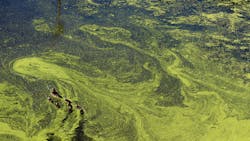Color-changing indicator predicts algal blooms
Researchers from the American Chemical Society say they’ve found an indicator that changes color when exposed to rising levels of alkaline phosphatase — an enzyme that forecasts phosphorus-related algal blooms. The change can even be detected by the naked eye or a smartphone.
Research has already shown that rising levels of alkaline phosphatase could forecast phosphorus-related algal blooms. However, current detection methods for the enzyme aren’t very sensitive or specific. So, the researchers wanted to use the reaction catalyzed by alkaline phosphatase to induce both fluorescence and visible color changes in a water sample.
To make the color-changing indicator, the researchers first combined copper ions with guanosine-5-monophosphate, forming spherical nanoparticles. Next, they incorporated two compounds (1,1,2,2-tetra(4-carboxylphenyl)ethylene and sulforhodamine 101) within the nanoparticles.
The result was a deep blue solution in visible light that fluoresced a bluish-purple under UV light. In the presence of alkaline phosphatase, the solution shifted to a pinkish hue and a strong red fluorescence under UV light.
The researchers tested the indicator with water from 13 river locations that had limited bioavailable phosphorus, calculating red-to-blue fluorescence ratios with a smartphone’s color scanning app. They found that the portable digital method reliably detected alkaline phosphatase and was as robust as benchtop measurements of the indicator’s fluorescence.
The researchers also grew toxin-producing cyanobacteria in the lab, feeding them complex phosphorus-containing compounds, and measured the alkaline phosphatase changes. On the third day, a large increase in enzyme activity was detected with both fluorescence and visible color changes. A few days later, the algae were growing exponentially. Because the indicator and smartphone-based system detected the activity surge prior to a bloom, the researchers say it could be developed for real-time field monitoring and prediction.
The authors have been funded by the National Natural Science Foundation of China, the National Key R&D Program of China, Shanghai Engineering Research Center of Biotransformation of Organic Solid Waste and the Fundamental Research Funds for the Central Universities.
Yuxin Luo, et al. Lanthanide-Free Infinite Coordination Polymer Nanoparticles for Real-Time Monitoring of Alkaline Phosphatase and Its Application for Digital Algal Bloom Detection. ACS, Applied Nano Materials 2021 4 (10), 11134-11144. DOI: 10.1021/acsanm.1c02596


